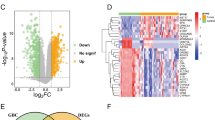Abstract
Background
Gemcitabine is a promising drug for cholangiocarcinoma treatment. However, the kinetics and metabolism of this drug in cholangiocarcinoma treatment are not well defined. We aimed to investigate the potential clinical role of gemcitabine metabolism-related genes in the gemcitabine sensitivity of cholangiocarcinoma and identify and characterize novel gemcitabine resistance-related genes.
Methods
Expressions of genes related to gemcitabine sensitivity and gemcitabine metabolism were measured in 10 cholangiocarcinoma cell lines, and the association between gene expression and gemcitabine sensitivity was evaluated. Furthermore, gemcitabine-resistant cell lines were established from YSCCC cells and subjected to genome-wide microarray analysis. The 2-fold upregulated and downregulated genes were then subjected to pathway analysis.
Results
p53R2 mRNA expression was significantly higher in gemcitabine-resistant cell lines (IC50 > 1000 nM), and all subunits of ribonucleotide reductase were upregulated in the established gemcitabine-resistant cell lines. Microarray analysis revealed that the upregulated genes in the resistant cells belonged to the glutathione and pyrimidine metabolism pathways, and that the downregulated genes belonged to the N-glycan biosynthesis pathway.
Conclusions
Increased expression of p53R2 may predict gemcitabine resistance, and upregulated RNR activity may influence gemcitabine resistance in cholangiocarcinoma cells. Glutathione pathway-related genes were induced by continuous exposure to gemcitabine and may contribute to gemcitabine resistance.




Similar content being viewed by others
References
Jemal A, Siegel R, Ward E, Hao Y, Xu J, Thun MJ. Cancer statistics. CA Cancer J Clin. 2009;59:225–49.
Shaib Y, El-Serag HB. The epidemiology of cholangiocarcinoma. Semin Liver Dis. 2004;24:115–25.
Khan SA, Thomas HC, Davidson BR, Taylor-Robinson SD. Cholangiocarcinoma. Lancet. 2005;366:1303–14.
Thomas MB. Biological characteristics of cancers in the gallbladder and biliary tract and targeted therapy. Crit Rev Oncol Hematol. 2007;61:44–51.
Olnes MJ, Erlich R. A review and update on cholangiocarcinoma. Oncology. 2004;66:167–79.
Anderson CD, Pinson CW, Berlin J, Chari RS. Diagnosis and treatment of cholangiocarcinoma. Oncologist. 2004;9:43–57.
Eckel F, Schmid RM. Chemotherapy in advanced biliary tract carcinoma: a pooled analysis of clinical trials. Br J Cancer. 2007;96:896–902.
Galmarini CM, Mackey JR, Dumontet C. Nucleoside analogues and nucleobases in cancer treatment. Lancet Oncol. 2002;3:415–24.
Heinemann V, Schulz L, Issels RD, Plunkett W. Gemcitabine: a modulator of intracellular nucleotide and deoxynucleotide metabolism. Semin Oncol. 1995;22:11–8.
Plunkett W, Huang P, Xu YZ, Heinemann V, Grunewald R, Gandhi V. Gemcitabine: metabolism, mechanisms of action, and self-potentiation. Semin Oncol. 1995;22:3–10.
Mackey JR, Mani RS, Selner M, Mowles D, Young JD, Belt JA, et al. Functional nucleoside transporters are required for gemcitabine influx and manifestation of toxicity in cancer cell lines. Cancer Res. 1998;58:4349–57.
Achiwa H, Oguri T, Sato S, Maeda H, Niimi T, Ueda R. Determinants of sensitivity and resistance to gemcitabine: the roles of human equilibrative nucleoside transporter 1 and deoxycytidine kinase in non-small cell lung cancer. Cancer Sci. 2004;95:753–7.
Hopper-Borge E, Xu X, Shen T, Shi Z, Chen ZS, Kruh GD. Human multidrug resistance protein 7 (ABCC10) is a resistance factor for nucleoside analogues and epothilone B. Cancer Res. 2009;69:178–84.
Sebastiani V, Ricci F, Rubio-Viqueira B, Kulesza P, Yeo CJ, Hidalgo M, et al. Immunohistochemical and genetic evaluation of deoxycytidine kinase in pancreatic cancer: relationship to molecular mechanisms of gemcitabine resistance and survival. Clin Cancer Res. 2006;12:2492–7.
Sugiyama E, Kaniwa N, Kim SR, Kikura-Hanajiri R, Hasegawa R, Maekawa K, et al. Pharmacokinetics of gemcitabine in Japanese cancer patients: the impact of a cytidine deaminase polymorphism. J Clin Oncol. 2007;25:32–42.
Davidson JD, Ma L, Flagella M, Geeganage S, Gelbert LM, Slapak CA. An increase in the expression of ribonucleotide reductase large subunit 1 is associated with gemcitabine resistance in non-small cell lung cancer cell lines. Cancer Res. 2004;64:3761–6.
Goan YG, Zhou B, Hu E, Mi S, Yen Y. Overexpression of ribonucleotide reductase as a mechanism of resistance to 2,2-difluorodeoxycytidine in the human KB cancer cell line. Cancer Res. 1999;59:4204–7.
Nakahira S, Nakamori S, Tsujie M, Takahashi Y, Okami J, Yoshioka S, et al. Involvement of ribonucleotide reductase M1 subunit overexpression in gemcitabine resistance of human pancreatic cancer. Intl J Cancer. 2007;120:1355–63.
Duxbury MS, Ito H, Zinner MJ, Ashley SW, Whang EE. RNA interference targeting the M2 subunit of ribonucleotide reductase enhances pancreatic adenocarcinoma chemosensitivity to gemcitabine. Oncogene. 2004;23:1539–48.
Zhou B, Mi S, Mo X, Shih J, Tsai J, Hu E, et al. Time and sequence dependence of hydroxyurea in combination with gemcitabine in human KB cells. Anticancer Res. 2002;22:1369–77.
Raphael M, John RM, Raymond L, Pieter D, Marc P, Marc P, et al. Human equilibrative nucleoside transporter 1 and human concentrative nucleoside transporter 3 predict survival after adjuvant Gemcitabine therapy in resected pancreatic adenocarcinoma. Clin Cancer Res. 2009;15:2913–9.
Jose GM, Miriam MA, Javier FC, Adela M, Marcal PA. Nucleoside transporter profiles in human pancreatic cancer cells: role of hCNT1 in 2′,2′-difluorodeoxycytidine-induced cytotoxicity. Clin Cancer Res. 2003;9:5000–8.
Townsend DM, Tew KD. The role of glutathione-S-transferase in anti-cancer drug resistance. Oncogene. 2003;22:7369–75.
Maring JG, Groen HJ, Wachters FM, Uges DR, de Vries EG. Genetic factors influencing pyrimidine-antagonist chemotherapy. Pharmacogenomics J. 2005;5:226–43.
Acknowledgments
We would like to express our immense gratitude to Ms. Yuka Kimura and Ms. Hidemi I for their technical assistance.
Author information
Authors and Affiliations
Corresponding author
About this article
Cite this article
Sato, J., Kimura, T., Saito, T. et al. Gene expression analysis for predicting gemcitabine resistance in human cholangiocarcinoma. J Hepatobiliary Pancreat Sci 18, 700–711 (2011). https://doi.org/10.1007/s00534-011-0376-7
Published:
Issue Date:
DOI: https://doi.org/10.1007/s00534-011-0376-7




